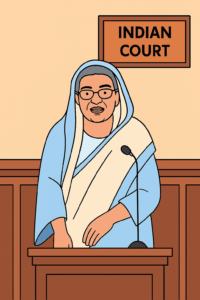
THE atmosphere in the Madhya Pradesh High Court was heavy with the burden of precedent and procedure, a gravity broken by the voice of the appellant. The wooden benches creaked, not under the strain of bodies, but in protest at the sheer temerity unfolding. In front of a division bench of Justices Vivek Agarwal and Devnarayan Mishra, a convicted killer was not asking for mercy, but lecturing.
“Are you a professor of chemistry?” Justice Agarwal asked, his voice a blend of interest and surprise. The query cut through the hush that had descended while the woman spoke.
Mamta Pathak, age 63, stood tall. Her white sari and plain, rimmed spectacles conferred on her the dignity of the scholar she was, a sharp contrast to the sombre actuality of her case.
She nodded, a deferential motion that was at odds with the fierce intellectual battle she was waging. “Yes,” she breathed, her voice then finding its confident classroom tone. For an instant, the stately room became a lecture room, and a life sentence teetered in the balance.
The case before her was that of the senseless electrocution murder of her husband, Dr. Neeraj Pathak, a senior doctor, on April 29, 2021.
Already convicted of life by a lower court, Mamta was now prosecuting her own appeal, armed not with precedent, but with textbooks of medical jurisprudence and toxicology.
Science vs. Suspicion
“In the post-mortem,” she started, her hands explaining as if to a dull student, “it is impossible to differentiate between a thermal burn and an electric burn without chemical analysis.”
Her premise was a categorical attack on the prosecution’s case on its very basis. She referred to the necessity of acro reaction and scanning electron microscopy to identify metal particles left in the tissue, a test she claimed was never conducted.
Justice Agarwal reminded her diplomatically that the doctor who conducted the autopsy did not have any such reservations, declaring categorically that the cause of death was electrocution.
Undaunted, Mamta, having devoted more than a year and a half to studying her own case, pushed further into her scientific refutation.
“Sir, electric burn marks cannot be described as ante-mortem or post-mortem with so much certainty. How did the doctors write so confidently?” she demanded, tracing lines in a dog-eared forensics text.
She even contested the time of death, questioning how the absence of extensive putrefaction on the body was incompatible with the post-mortem’s calculation.
Her act, recorded in a video that would eventually become viral, was otherworldly and captivating: a lecturer performing a masterclass in forensic science while standing trial for her life.
The Weighing of Evidence
To Professor Pathak, the case was a sequence of failed experiments gaffes during the autopsy, a contempt for insulated wiring at her home which she insisted made electrocution impossible, and untested hypotheses of electrochemistry. But to the court, this scientific camouflage could not hide a chilling array of circumstantial facts.
The prosecution outlined a grim and engrossing picture of a marriage infected with discord and suspicion of adultery. They produced evidence that on the day of his death, Dr. Pathak had placed an urgent call to a friend, saying his wife had been harrassing him for days and had him locked in a bathroom.The tape of that desperate call rang out in the courtroom, a voice from the dead.
The court was told how Mamta Pathak had given Olanzapine, a sedative, to make her husband unconscious before passing the lethal shock. Sleeping pill strips and wire from a two-pin plug had been taken from the property. Most incriminatingly, following her husband’s death during the evening of April 29th, Mamta did not report the incident to the police.
Rather, she waited two days, the quiet a calculated, icy emptiness. Her actions in those first few hours—the departure from home with her son to drive more than 100 km to another city to get dialysis—were considered suspicious in the extreme by the court.
The Final Verdict
Mamta Pathak’s defense was a tour de force of intellectual intensity, a fervent, scholarly performance to which the court had rarely been witness. But law, unlike academic science, requires conclusiveness. It demands evidence beyond a reasonable doubt, rather than the presentation of an infinite number of academic questions.
In the High Court last month, it handed down its 97-page ruling. The appeal was rejected. The life sentence was confirmed. The bench determined that the chain of events—the motive, the victim’s terror-stricken telephone call, the sedatives, the delay in reporting his death, and her being the only one with him—was intact and unbroken. Her professorial hypotheses, no matter how advanced, couldn’t do away with the hard, cold realities of the case.
Ultimately, chemistry was no match for circumstantial certainty. Mamta Pathak had made her trial her last, most theatric lecture. But the court granted no marks for originality—only the unforgiving weight of a conviction.
We strive to make a lasting impact on India’s policy and planning landscape through fair, unbiased, and incisive research based journalism.
But we can’t do it alone.
Together, we can create a better India, where policies are fair, planning is unbiased, and the truth prevails. Your contribution matters, and we shall be immensely grateful for your support.

